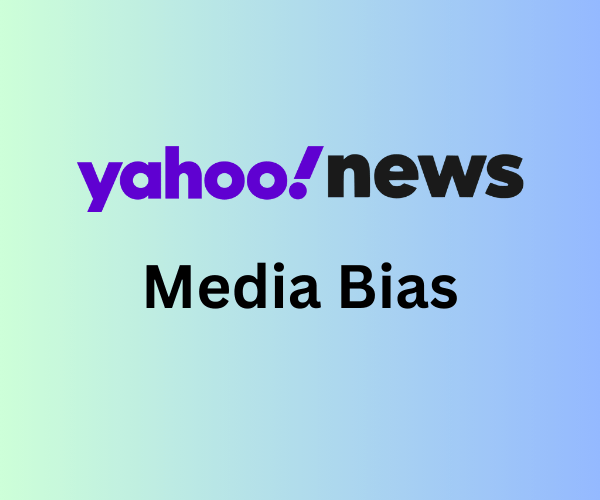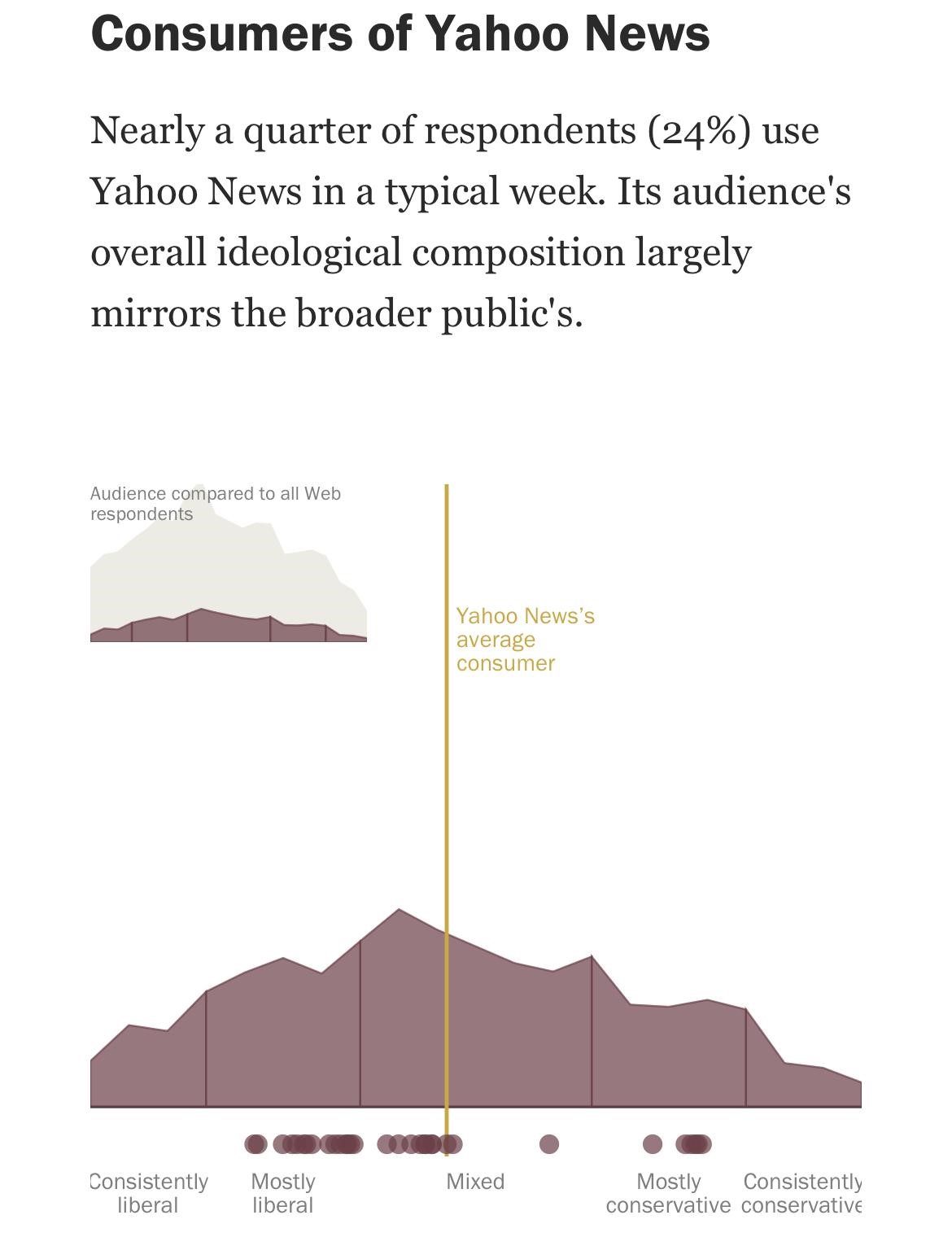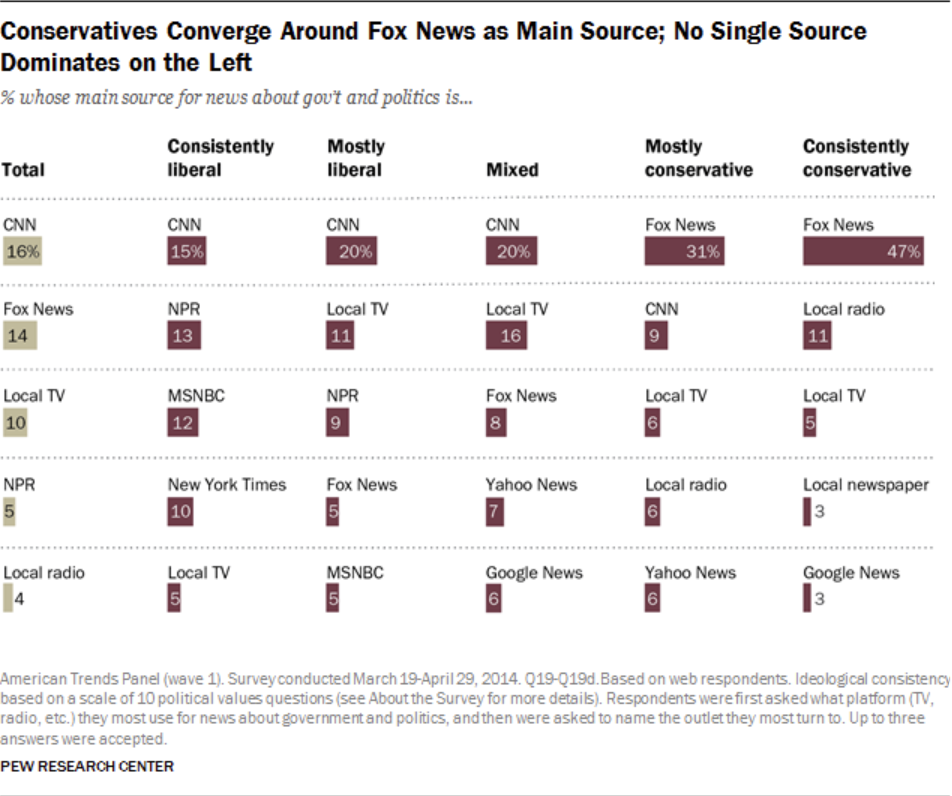
Established in 1996, Yahoo News has become a notable presence in the digital media landscape. With its commitment to providing timely and relevant information, Yahoo News has become a widely consulted source for many readers, reinforcing its reputation as a credible news outlet in the continuously evolving realm of online journalism.
While Yahoo News aims to provide diverse perspectives, some critics argue that its coverage may display subtle biases influenced by the inherent subjectivity of journalism. Evaluating individual articles and considering multiple sources remains crucial for comprehensively understanding the news landscape. According to the Pew Research Center, In 2014, approximately 24% of survey participants engaged with Yahoo News every week. The ideological composition of its audience closely aligns with the broader demographics of the general public.

Source: Pew Research Center
In this article, we will analyze the outlet’s coverage and editorial decisions to determine if there is a discernible political bias in their reporting. Through our analysis, we hope to shed light on as many contributing factors to media bias as possible.
How Does Biasly Rate News Sources?
Biasly’s algorithms produce bias ratings to help provide multiple perspectives on given articles. Biasly has analyzed 200,000+ news articles from more than 3,200 news sources through our A.I. technology and team of political analysts to find the most factual, unbiased news stories.
Biasly determines the degree of political bias in news sources by using Biasly’s Bias Meter Rating, in which Biasly’s team analyzes media sources’ reliability and bias and produces three scores, a Reliability Score that measures the accuracy of media sources; an A.I. Bias Score, evaluated by A.I.; and an Analyst Bias Score evaluated by political analysts. These scores are rated based on seven rating metrics including Tone, Tendency, Diction, Author Check, Selection/Omission, Expediency Bias, and Accuracy. These metrics help our analysts to determine the political attitude of the article.
Our A.I. machine-learning system employs natural language processing and entity-specific sentiment analysis to examine individual articles and determine their bias levels. By analyzing the key terms in an article such as policies, bias phrases, political terminologies, politicians, and their nicknames, the algorithms can rate the attitude of the text. Bias scores range from -100% and 100%, with higher negative scores being more liberal and higher positive scores being more conservative, and 0% being neutral.
Is Yahoo News Politically Biased?
Consistently conservative individuals primarily rely on Fox News (47%) as their primary news source. At the same time, those with liberal views have a more diverse range of outlets, with no single source predominating. 6% of consistently conservative individuals mentioned Yahoo News. It is also part of the “long tail” for those with a mix of left and right-wing values:

Source: Pew Research Center
Biasly’s rating for Yahoo News originates from two scores, one from its computer algorithms, based on A.I., and one from its Analysts. Biasly rated Yahoo News with a Computer bias score of Somewhat Liberal and, interestingly, an Analyst bias score of Moderately Conservative, which means, overall, it provides a mix of political coverage from American liberal and conservative political perspectives. We calculate analyst scores based on an average of at least 15 articles reviewed by one liberal, moderate, or conservative analyst. The more articles Biasly’s analyst team rates for a particular source, the more accurate the analyst score will be. Praise for liberal politicians and policies, as well as dislike toward Republican policies and politicians, contribute to this rating. Biasly’s scores closely align with determinations by other third-party bias research agencies.
Throughout the rest of this article, we will explore methods to discern bias, enabling you to distinguish between opinions and factual information, ultimately empowering you to be a more discerning news consumer.
Before we begin, we need to discuss bias. Bias is a natural function of humans, and we can express it both consciously and unconsciously. Bias is one of the most fundamental forms of pattern recognition in humans. This isn’t to lower the bar and say that “all things are biased,” but to explain the process in which we may come to trust certain news organizations that display patterns of coverage.
On the media’s part, there is an incentive to retain audiences, encourage them to purchase subscriptions, and rate products positively. Bias is a two-way street, people want to see news stories about things they care about, and the media needs viewers to continue their operations. This creates a positive feedback loop that influences what stories are covered and from what perspective. This also explains the actions of more liberal news organizations.
Analysis of Bias in Yahoo News Online Articles
When determining bias, the most common metrics are tone, tendency, author, diction, expediency bias, selection/omission bias, and accuracy. Tone refers to the attitude of the writing and is related to but distinct from diction, which is the writer’s word choices. The author metric refers to the writer of the article and their demonstrated stance on issues through past works and social media posts. Next, expediency bias concerns the reader’s reaction to the headline/image/article summary. It also measures how quickly the reader feels emotion and whether there are any elements of clickbait material.
In addition, two other types of bias, selection/omission, focus on whether the author overlooks particular facts/info to sway readers or selects/includes more insights from one side to build the story. The political alignment of the story (left or right) is also essential to keep in mind for this metric.
Finally, regarding accuracy, there are three main points to consider: Are the facts in the article correct? Are there enough sources? Are the sources credible? These determinations require research in other articles on the same topic, which may lean left, be moderate, or have right-wing perspectives.
The first article we will examine is “Takeaways from the blockbuster Trump ‘insurrectionist ban’ ruling.” Biasly has rated this article as “Very Liberal” on the Bias Meter. The partisan tone is evident in the choice of language and framing of a Colorado judge’s ruling, which fell short of declaring Trump ineligible for the state ballot. The decision, which passed successfully in December 2023, resulted from Trump’s violation of section 3 of the 14th Amendment, forbidding civil and military officers of the United States from aiding in insurrection. The article characterizes the decision as “stunning,” asserting that the 102-page decision “read more like a condemnation.” This choice of language reflects a subjective perspective on the outcome.
The writing style in this article is notably clear and informative, emphasizing a detailed account of the legal proceedings and decisions surrounding Donald Trump and the Colorado judge’s ruling. The author maintains a formal tone, suitable for reporting on legal matters. Furthermore, there is a strong focus on factual reporting, with each paragraph typically introducing a new aspect of the case or a new development.
The article’s structure is logical and sequential, starting with a summary of the judge’s ruling and its implications, then delving into the specifics of the ruling, Trump’s actions, and the legal arguments involved. This structure aids in the reader’s comprehension of complex legal issues by breaking them down into more digestible segments.
There is also a balanced use of direct quotes and paraphrasing, which provides credibility to the reporting by directly citing the sources and summarizing key points for clarity. The author also effectively uses these quotes to emphasize significant points or to highlight the Colorado judge’s perspective.
Additionally, the article includes analysis and context, such as the historical application of the 14th Amendment and the significance of this ruling in the broader legal landscape. This context helps readers understand the more significant implications of the verdict.
In terms of language, the article uses legal terminology appropriately, yet it remains accessible to a general audience. The author avoids overly complex language or legal jargon, making the content understandable to readers who may need a background in law.
As for the author himself, Marshall Cohen’s Twitter profile mostly refrains from incorporating his biases and personal opinions. Although Cohen has covered divisive topics from a somewhat neutral point of view, such as the 14th Amendment cases to remove Trump from the ballot, the Hunter Biden laptop scandal, or other political events, he did retweet something from a journalist at BBC named Shayan Sardarizadeh, which discusses Elon Musk and his faith in a source that routinely makes questionable posts about Jewish people:
The first account recommended by Elon Musk is well-known for highly questionable posts about Jewish people, and the second is one of the worst “osint” accounts when it comes to posting misleading and unsourced content. pic.twitter.com/F2TZMb3wUH
— Shayan Sardarizadeh (@Shayan86) October 8, 2023
This retweet suggests that Marshall Cohen likely leans left politically, especially since he is a journalist with CNN.
Regarding objectivity, Cohen’s article strives for impartiality by presenting Wallace’s decision, its essential components, and relevant context about the 14th Amendment and the January 6th committee. Including background information contributes to a more comprehensive understanding of the case’s legal intricacies. However, the language employed to characterize the ruling introduces a potential element of personal interpretation, indicating a particular viewpoint or bias in presenting the information.
That said, for the most part, the article provides reliable insights into the legal aspects of the case, allowing readers to form unique conclusions. Including relevant context on the critical components of the verdict contributes to a more well-rounded understanding of the legal proceedings, balancing the potential for bias with a commitment to providing a comprehensive overview of the situation.
Analysis of Yahoo News Opinion Articles
Before delving into this section, we must distinguish between opinion and reporting. Reporting should be as neutral as possible, giving the reader the facts and quotes from primary sources to let them form their own opinion. Opinions are an outlet for columnists to express their personal views.
For example, this opinion article comes with a significant left-wing bias: “Sean Hannity Gets Weird In Interview With Fight-Starting GOP Senator.” Biasly’s A.I. rating for this piece is “Extremely Liberal,” mainly due to the use of hostile language against Hannity and Republican Senator Markwayne Mullin. During the interview, the latter addressed a recent incident he was involved in, where labor union leader Sean O’Brien challenged Mullin to a physical altercation during a Senate committee hearing. This story, as reported, provides several points for analyzing potential liberal bias. Terms like “weird,” “apparently thinks it’s totally cool and normal,” and “wild back-and-forth” convey a critical tone toward Hannity’s opinion of the incident.
The article opens with disbelief and disapproval towards Hannity’s endorsement of physical confrontation to resolve disputes, particularly among high-ranking officials like U.S. senators. This view immediately sets a critical tone towards conservative figures like Hannity and Mullin, which could be indicative of a liberal bias.
The article then describes the altercation, painting Mullin as overly aggressive and confrontational. The author implies Hannity’s support for Mullin’s actions endorses outdated or uncivilized behavior, meaning the reader could interpret this to mean that conservative views are regressive or disconnected from modern societal values.
The article also quotes Mullin saying, “It’s political correctness,” criticizing the left for having the freedom to say what they want without similar repercussions. This typical conservative viewpoint highlights a perceived double standard in public discourse. However, the article does not dwell on this perspective, instead focusing on the theatrics and backlash from Democrats, framing their criticism as a reasonable reaction to “childish and unacceptable” behavior.
Who Owns Yahoo News?
The initial form of Yahoo! Inc. was a technology conglomerate based in Sunnyvale, California, with its roots dating back to January 1994, when Jerry Yang and David Filo established it. Officially incorporated on March 2, 1995, Yahoo played a pivotal role in the early stages of the internet during the 1990s. Since 2017, Yahoo has been under the ownership of Verizon Communications, following Verizon’s acquisition of Yahoo and AOL in 2015 and 2017, respectively. The amalgamation of these two entities resulted in the formation of Oath Inc., a subsidiary of Verizon Communications.
In 2021, Verizon disclosed that Apollo Global Management would take over Verizon Media for approximately $5 billion, finalizing on September 1, 2021. Apollo’s acquisition of Yahoo and AOL amounted to $5 billion, a figure lower than the combined annual revenues of the two companies at that juncture. Notably, Jim Lanzone, pictured below, serves as the current CEO of Yahoo.

Source: Wikipedia
Even though readers widely regard Yahoo News as a liberal source, Lanzone once retweeted advice he received from J.P. Morgan regarding objectivity and effective news dissemination:
Good advice from @jpmorgan CEO Jamie Dimon:
“Study everything. Learn, learn, learn. Don’t get rigid in how you think. I’ve been reading four to five newspapers a day for like 30 years. Be open minded when you look at an issue, assess the whole issue.”
More from our chat on… pic.twitter.com/2dMwBRMWMS
— Brian Sozzi (@BrianSozzi) November 2, 2023
This advice underscores the nuanced approach necessary for fostering credible and balanced journalism in today’s diverse media landscape.
How to Evaluate and Uncover Bias
It can often be difficult to tell if the news you watch is biased. If you have settled on a news channel, it’s usually because you trust the information you are gaining. Unfortunately, many trust the information they are hearing because it confirms what they already believe. This is referred to as “confirmation bias.” It is important to challenge your beliefs and get third-party verification that what you are hearing is the full story. This is why we recommend using Biasly to compare different news stories side-by-side using our bias ratings to figure out what both sides think of a political issue.
Even though Biasly gave Yahoo News a Somewhat Liberal score, remember that bias varies. Since some articles stick to the facts better than others, Biasly’s News Check is a valuable tool for helping readers determine the biases of what they read.






















